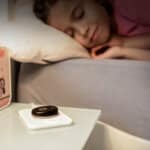Use Your Tablet to Teach Your Child

Screens are ay part of everyday life, both at work and in our free time. We use them to communicate with others, read, watch television and films, listen to music, play games, draw, attend meetings, write, browse social media, and more.
As devices are used in so many ways in our lives, it is essential that we know how to use them to our best advantage so that they can be learning tools for children with hearing implants. Remember that the most valuable tool for learning with tablets is you. When you sit together with your child, the fun and learning can begin!
Here are some tips for using tablets to help your child with a hearing implant learn.
1. Ensure That Your Child Is Hearing Well When Using the Device
Streaming technology allows the sound from a tablet to be heard best by a person who uses hearing technology. Make sure your child can hear well when using the device.
2. Choose a Television Program or Film to Watch
Choose a program with:
- An interesting plot that is simple enough for your child to understand
- Clear voices and limited background noise or music
- Positive characters as role models
3. Watch Television Programs or Films Together
Sit with your child and watch the program together. Children will learn a lot from the program they watch on the tablet if you sit with them and watch the program together.
- Talk about what is happening at the level of language your child understands or slightly above. For example, “Look! There’s Peppa Pig–she says oink oink,” “Oh no, Paddington is feeling embarrassed because he made a mistake in the football game.” Try not to talk at the same time as the characters.
- Pause the program occasionally and talk about what’s happening or guess together what might happen next. For example, “Oh no, where’s the bear?,” “Gosh, the Octonauts need to rescue those animals from the trees. How do you think they could do that?,” “That was an exciting part wasn’t it? Poli must be feeling very proud of his achievement.”
- Remember to talk together about the program after it has finished. For older children, include discussions about the characters–what they did and how they might have felt. “Peppa Pig was brave saving her friend from the water! I bet Mummy and Daddy Pig are proud of her. When have you felt proud?”
4. Watch Music Videos Together
Sit with your child and watch a music video together.
- Choose music with clear, easy-to hear-lyrics and fun gestures and actions to follow along with.
- Sing along with the songs.
- Have fun doing the actions together. Your child might not do the actions the first time they see a video, but they might do them when they’ve heard it several times.
- If your child asks for the music video again, do it again together! Repetition helps young children learn language.
5. Play Games Together
Sit with your child and play games together. Again, children can learn a lot from playing games if you sit together with them and talk to them. Choose games that are educational and that are not too fast-paced with distracting visual or auditory effects.
- Choose a game with little or no extraneous background noise or music, or go to settings to turn the music off.
- If the sounds on the game are not important, then turn them off. This gives your child the best chance to learn from your language input when playing the game together.
- Talk about the game and how it works at the level of language your child understands or just above. For example, “He’s going up, up, up!,” “We have to move the fish up every time the big wave comes,” “Oh no, CRASH!,” “You’ll have to be careful, or the boy might fall into that dangerous chasm!”.
- Use the language associated with tablets, for example, swipe, tap, play.
- Show your child icons used on tablets, for example, the arrow for play.
Thanks for your message. We will reply as soon as possible.
Send us a message
Field is required
John Doe
Field is required
name@mail.com
Field is required
What do you think?
The content on this website is for general informational purposes only and should not be taken as medical advice. Please contact your doctor or hearing specialist to learn what type of hearing solution is suitable for your specific needs. Not all products, features, or indications shown are approved in all countries.


